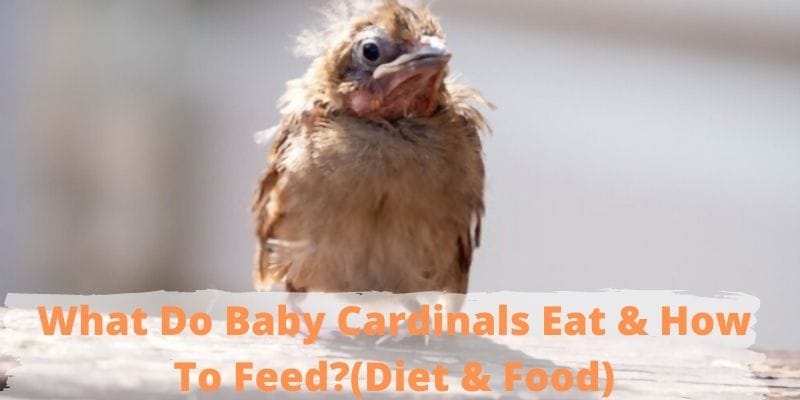Baby birds are not capable of eating all the foods which adult birds can easily eat. They are capable of eating most of the food which fits in their beaks. Also, feeding baby cardinals is a crucial part of their care. That’s why many people have asked online portals about what do baby cardinals eat.
Baby cardinals can eat several foods enriched with proteins and other essential nutrients such as insects, mealworms, seeds, moistened dog food, etc. Know how you can properly feed the baby cardinals.
Table of Contents:
- What Do Cardinals Feed Their Babies?
- What Can You Feed Baby Cardinals?
- How To Feed Baby Cardinals?
- How Much To Feed Baby Cardinals?
- How Often Do Baby Cardinals Eat?
- What To Avoid Feeding Baby Cardinals?
- Can Baby Cardinals Eat Worms?
- Can Baby Cardinals Eat Bird Seeds?
- Can Baby Cardinals Eat Bread?
- Conclusion
What Do Cardinals Feed Their Babies?
Cardinal parents feed their babies with crop milk and insects that provide the nutrients required to develop their muscles. Baby cardinals eat soft-corporate insects like caterpillars when they are extremely young.

What Can You Feed Baby Cardinals?
You can feed baby cardinals several kinds of seeds, insects, worms, and grains. But the foods for newborn cardinals are different, and you can feed them moistened dog foods, cat foods, and other foods discussed below.
Be very cautious when feeding newborn cardinals. Some people think it is perfect that provide milk from droppers to baby cardinals who fell out of the nest, but this is not true.
Baby cardinals do not depend on milk, and birds do not feed milk to baby birds as part of their natural diet. Therefore, never attempt to supply baby cardinal milk or milk protein products since they are harmful rather than satisfactory.
As the baby cardinals become older, it is also advisable to add mealworms and other items, such as fruit or seeds. But if you have found a newborn baby, then the foods are different for them that are discussed below.
They eat wild grapes and different types of berries in the wild. Their nutrition can be different from other herbivorous birds. Cardinals like to eat seeds, ground, and shrub food.
With their strong beaks, they break the coats and then consume the meat. Sunflower grains are loved by the Cardinals, especially sunflower seeds from black oil. Unfortunately, the cardinals can eventually destroy their thin casings. What do baby cockatiels eat?
What To Feed Newborn Cardinals?
If you want to feed newborn cardinals, then crop milk, raw liver, and other protein-enriched foods will be the best options to feed them. You have to feed them with your hand by using a syringe or any other alternative.
Their parents nourish baby cardinals. The female cardinal will remain on the nest for the first 11 to 13 days of his hatching so that the hatching is warm, and the male will scout and give it to the females and the chicks.
The cardinal will also help feed her younger birds from day 25 to 56. Cardinal parents almost entirely feed their young with insects that provide the necessary protein to grow their muscles.
Baby cardinals eat soft-corporate insects like caterpillars when extremely young. While young chicks, the mothers mainly eat insects and feed the young chicks with their food. As chicks grow older, parents can choose to catch entire insects and offer them.
In a warm and cozy ecosystem, displaced baby cardinals must be kept. A low-heat box is perfectly suitable. Cardinal babies may be fed with moistened dog foods or cat meals.
Three-and-a-half dog or cat food can be soaked and offered to the chick along with one-and-a-half soft fruit such as berries. The food should be mixed if the chicken is incredibly tiny.
Larger nestlings require healthy food. Every 15-30 minutes from morning to night, baby birds have to be fed. You can also offer specialty foods such as parrots in pet shops for baby cardinals.
When the bird begins flying, the cardinal must be transferred to a bird feeder outdoor area to learn to feed himself.
How To Feed Baby Cardinals?
Feed baby cardinals with tweezers or a dropper, according to how old they are. Feed baby bird approximately every 20-30 minutes but do not force it for eating. You do not have to give water to baby cardinals.
The baby cardinals usually eat their mothers’ seeds and insects. For example, you eat sunflowers of black oil, safflower, and milo seeds of white. Grasshoppers, mealybugs, katydids, and gypsy moths are common insects that baby cardinals eat.
The young cardinal’s dietary demands appear more opportunistic eaters in nature than birds and mammals. The adults circumvent their usual seeds and look for little bees and wasps almost entirely for chicks to feed.
Cardinals require diets rich in fats and proteins, which are nothing but insects. This medication works them in the early phase. Cardinals for babies shall be fed at least three times and at most eight times per hour.
How Much To Feed Baby Cardinals?
Feed the baby cardinals with wingless flies, food worms, wax worms, and crickets. When they are fully conscious, you must feed the baby bird every 15 to 20 minutes.
This program lasts only about two weeks, and then you can lower your baby bird feeding uniformity. After a while, the baby bird’s hungry, you are going to tell, because the baby is going to open his mouth and stick his head back.
Do not feed the bird with milk or flesh products such as ants or caterpillars. In the natural environment, the food for adult female consists of insects, spiders, wild foods, fruit, and grain.
In winter, the diet of the Cardinals is based upon more plants, including wild seeds and fruits. Some insects may be observed under the foliage to add to their eating habits.
Winter bird feed intake stations may be enticed by providing Black-oil sunflower seed and safflower seed. The ideal bird feeder is the napkin style, preferable to a window ledge while eating at flower beds.
How Often Do Baby Cardinals Eat?
You can feed your baby cardinals at least three times per hour to a maximum of eight times per hour. Do not increase or decrease the quantity. When the baby cardinal is one week old, there comes a slight change in its food routine.
Food is offered to baby cardinals four times an hour, not less or more than that. This routine continues for almost six weeks. When baby cardinals are six weeks old, they start flying and start feeding by themselves.
What To Avoid Feeding Baby Cardinals?
The food that you should avoid feeding your baby cardinals includes kitchen scraps, milk, bread, or any bread product, water, whole birdseed, and worms.
Along with these things, do not feed your baby cardinals broccoli, wet bread, or dry chicken. When your baby cardinals become an adult almost six to seven weeks old, they can eat these things. Until then, avoid serving these things as food to them.
Can Baby Cardinals Eat Worms?
Yes, baby cardinals can eat worms. But only if you can feed them worms in small pieces when they are young. When baby cardinals grow older, you can give them giant insects and even whole worms.
Every young cardinal can eat 14 feet of earthworms in a two-week nest life, but worms are not their leading food. They love eating pests, and ground snails, including many other insects, like grasshoppers, cutworms, and bollworms, which can damage gardens and farms.
Can Baby Cardinals Eat Bird Seeds?
Yes, baby cardinals can eat seeds and love eating them, no matter which type of seed you are serving them.
These young birds are of medium size and can eat various types of seeds such as safflower, sunflower, black oil sunflower seeds, white milo seeds, crushed peanuts, cracked corn, suet, etc.
There are more than forty seeds that a baby cardinal can eat. But the seed that baby cardinals love the most is the safflower seed.
Their shell is thick because other birds do not eat them, so it has less competition than the other seeds. Baby cardinals are very small and cannot fly, so the parent cardinals have to feed their young ones the necessary food. And if the parent bird is not there, then you have to feed them.
Can Baby Cardinals Eat Bread?
Baby birds will not digest bread, so it will not be very meaningful to give them this food. The bird’s frequent bread trying to feed a bear cub or an adult bird will lead to malnutrition.
Furthermore, pests like rats or insects can be attracted by bread left outside by baby birds. Occasionally people give bread to birds, and this is no problem if moderately tried to offer.
Birds may digest all types of bread, but this food is not supposed to form much of a diet for grown-up birds. But even if adults can, baby birds can still have bread.
The body of baby birds can not break food, so the parents give baby birds crop milk. Crop milk is a metabolite made by parent bird cultivation.
It contains all the essential nutrients that infants require, and it is easy to digest the crop milk. Baby birds cannot digest bread so it will be meaningless to give them that food.
In regards, bread is a risky move to give the animal, even if a baby bird can digest food. Bread is not the protein and fat essential for the bird in its diet. This food fills the bird with the required nutrients.
Conclusion
The food list for baby cardinals can not be assumed the same as that of adult cardinals. It is important to know what are good and healthy foods for them and what baby cardinals eat, including their ability to consume them.
A maximum of four meals per hour is changed after a week in the feeding regimen of baby cardinals. It lasts six weeks after six weeks until baby cardinals begin to jump as well as feed. Not because of protein, though, we have not seen insects.
Bees, wasps, and ants have a protein content of 770 g per 1 kg. These are the highest rate of protein for insects.
The actual bug that was also known as the water bug came after the insects. It has a protein content of 740g per 1kg. Next are beets with 650 g of protein per 1 kg of flip and cricket.
Birdskeeping is supported by its readers. When you purchase through links on our site, we may earn an affiliate commission. Also, as an Amazon affiliate, we earn from qualifying purchases without costing you extra.
